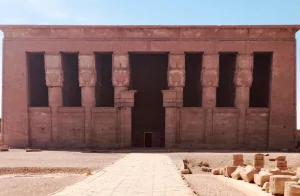templo de Dandara

Dandara is a famous temple for the people who love visiting Lúxor to take the chance to visit the famous Temple of Hathor at Dendera or Templo de Dandara as the local people call it. Generally, it takes about an hour from Lúxor (70 km) by car trip. The Temple is about 4 km from the River Nile, on its west bank, roughly opposite the city of Qena. The capital of the governorate of Qena has a population of 2,000,000. This town is very famous for manufacturing water pots, called “gula” in Arabic. The Temple of Hathor built in the 1st century B.C. Further, it is one of the best-preserved Temples in Egypt. People built it during the reign of Ptolemy VIII and Queen Cleopatra II. Later, the Roman Emperors continued to decorate it and honor Hathor; the Goddess of maternity, love and music. The Greeks identified the Hathor as Aphrodite.
The architecture of the temple of Dandara
In fact, Roman Emperor Domitian built the first gateway in 80 A.D. It leads to the great hall of the Temple which has decorations of Historic columns. Further, The upper front edge of the cornice is decorated with the winged sun disc. Stone screens between the columns and the scene. Indeed, it represents the Roman Emperor Tiberius Tiberio y otros monarcas romanos que presentan ofrendas votivas a la diosa del templo.
There are remarkable scenes on the walls of the first hall of the temple. For instance, it depicts sacrifices being made to the Goddess of the Temple. The amazing ceiling, with its astronomical representations. Moreover, the ceiling is divided into 7 divisions. The best remaining 3 are: The first one on the eastern side depicts Goddess Nut, Goddess of the sky, bending herself towards the earth with the sun disc shining on the Temple and the mask of Hathor.
The second one represents the sun boat and star Goddess. Furthermore, the third one is the western ceiling. It shows a perfect representation of the zodiac signs. Hat is one of the reasons that the Temple is so famous (the original zodiac relief is now in the Louvre museum in Paris, France). The 12 figures of the ram, the bull, the heavenly twins, the crab, the lion, the virgin, the scales, the scorpion, the archer, the goat, the watering pots and fishes with glittering tails.
On the inner walls of the screen, there are the hawk headed God Horus, and the Ibis headed God Thoth. They are pouring drops of holy water over the King. This scene is the baptism scene, symbolizing life and happiness.
The second hall has 6 columns adorned with rich capitals and granite pedestals. On both sides of the hall, there are small rooms. People used them as storerooms to store the wine jars of the Island of Crete and the fertile Fayoum and Kharga Oasis. Besides, there is the central chapel that has two altars. One is for the sacred boat. However, the other room is for the offered sacrifices to Goddess Hathor.
Hathor temple
The beautiful sculptural reliefs on the walls of the shrines represent Ptolemy VIII and other rules, whose names are blank in the oval cartouches, dancing with offerings to the sacred boat of Hathor and her husband Horus. The representatives of the King, the high Priests and noblemen, used to gather in the great hall in preparation for the daily rituals.
The ceilings are in stars, and black soot from the fires of the later inhabitants of the Temple. The rooms around the sanctuary used for scientific purposes, the storing of the sacred boat, the sacred wreath, the golden image of the Goddess Hathor and musical instruments.
There is a small corridor on the right side, which leads to a small room that contains the crypt. It is highly recommendation should you visit there. The staircases decorated with some beautiful symbols. On the eastern corner of the roof, there is the chapel of the God Osiris. The scenes on its walls represent Osiris rising from the dead and becoming the God of the underworld. It is from this chapel that the best representation of the zodiac taken.





